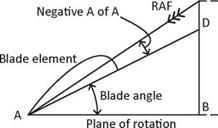Experimental Pitch
The experimental pitch can be defined as the ‘prop’s advance per revolution when producing zero net thrust’.
An inspection of Diagram 3, Experimental Pitch, shows as the advance per rev (APR) increases from B to E, the angle of attack will reduce to a negative angle (AD-AE) of around minus two degrees and the propeller will cease to produce thrust. In
this condition the relative airflow acts along the line from E to A, and corresponds to the wing’s ‘zero lift line’, to become the prop’s zero thrust line. This is the important aerodynamic feature of the experimental pitch. From the designer’s point of view, it is considered as being the ‘ideal pitch’. Because it has a definite value and length, depending on the prop’s characteristics, it can be used for experimental measurements, hence the name
![]()
![]()
![]()
 Experimental
Experimental
pitch
A fixed-pitch propeller has only one experimental pitch, while a constant-speed prop’s pitch is variable over the available operating range of the blade angles between the fine and coarse pitch stops. The experimental pitch may also be known as the ‘zero thrust pitch’ or the ‘exponential mean pitch’











